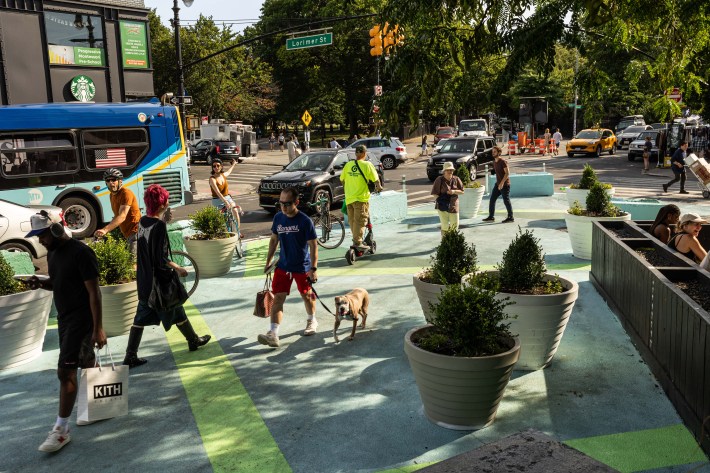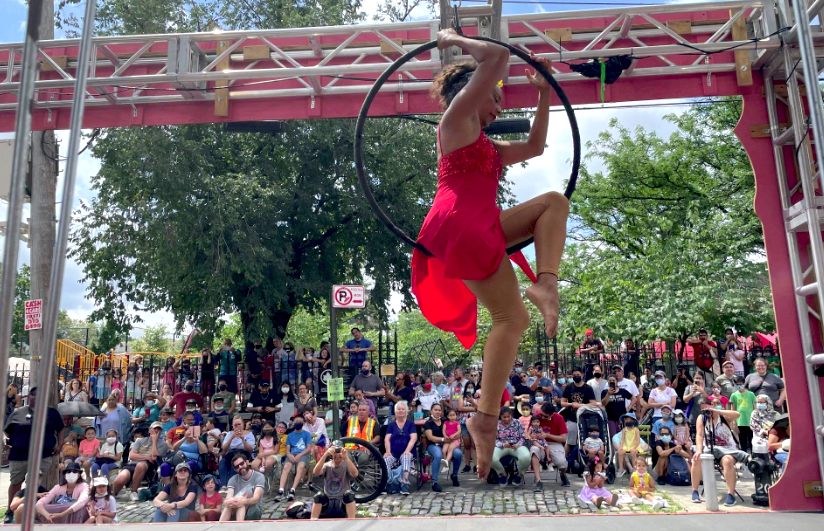Is New York City boring?
At a recent conference, I heard a group of planning experts from other cities bemoan the “sameness” of public spaces in the Big Apple. From Corona to Crown Heights, you see the same planters, the same metal chairs, and the same brightly colored paint. In fact, you see the same designs in Detroit, San Francisco, and Philadelphia. What’s the point of being in New York City when you can squint and think you’re in Denver?

It may seem frivolous to worry about the specificity of public space when we simply more of it. But even the most hardened public space advocate has to admit that we’re doing well here in terms of quantity. Since the Bloomberg era, the DOT Plaza Program has created over 100 new spaces. After the pandemic began, Open Streets and Open Restaurants showed that we can create public space quickly. Each of these programs has its ups and downs, but the overall trend is in the right direction.
But quantity does not equal quality. An open street is often just two metal barricades, a square may be just asphalt paint and concrete blocks. Making these meager spaces into special places is more important than you might think. Sociological studies show that our sense of belonging and “place attachment” are influenced by local landmarks and positive social interactions in public. A good public space can provide both – connecting people to each other and to their neighborhood.
So how can a cash-strapped city help foster what I call “contextual public places,” places that reflect and create the identity of the neighborhood and provide that special sense of belonging? The answer cannot simply be “better” design if those responsible for public space continue to struggle for adequate funding. More than that, it is People that most immediately enliven a space. The easiest way to make a public space a reflection of its neighborhood is to design it to attract locals.
I spent this summer in two Brooklyn plazas that use programs to create and reflect neighborhood identity. Kensington’s Ave C Plaza serves as a seating area after prayers at the local mosque, a rehearsal space for children who want to practice Mexican folk dances, and an outdoor stage where I recently listened to musicians perform a mix of Bengali and Jewish folk songs. Further north in Greenpoint, Bedford Slip Plaza captures the spirit of environmental activism, eclectic small shops, and even the neighborhood’s vintage vibe. These plazas both use standard DOT tools, but I couldn’t imagine either of them in any other neighborhood. And while much of what I just described happens organically, much of it is intentionally encouraged by local organizers.
I imagined that the people behind these spaces were like creative directors who thought up and implemented programs. But the key to a contextual public space is not from scratch. Instead, the spaces’ organizers cultivate and highlight the culture and activities that occur organically around them. Many of the artists who animate Ave C Plaza met because their children attended the local public school. When the plaza opened, organizers were able to turn this informal network into a huge source of talent. Many of the volunteers who run Bedford Slip are also involved in local environmental and service groups that have supported events in the temporary space. These deep, complex neighborhood networks elevate these places to true neighborhood centers.

As a city, we can do more to support this kind of work. The Department of Transportation knows it’s not a grassroots movement, and wisely works with civic groups to enliven its spaces with culture and activities. The department’s Public Space Equity Fund has provided grants for programmers working outside areas covered by wealthy commercial parks or conservation areas. But problems persist: Most of the grants are expense reimbursements, and the city often pays late. One organizer I spoke with racked up credit card debt for an event, thinking the city would pay it back the next month. When the city defaulted, he had to take out a loan to pay off his organization’s debt.
Most agencies that fund programs require applicants to be nonprofits. While this requirement makes sense, for many, establishing a nonprofit is a prohibitive step. A music group may want to perform at a local venue for payment while also wanting to perform in public spaces for free. Such a for-profit group would be barred from applying for city funds. In many cases, grassroots programmers must convince a local nonprofit to apply on their behalf if they want to access city funds. Many of these funds are also structured to support one-time events rather than year-round programming calendars. We should structure the funds to support regular grassroots programs in public spaces, with funds for multi-year periods and the possibility of formal financial sponsors for applicants who cannot become nonprofits.
Finally, the city could help address some of the physical constraints on programming. Storage is a big issue. All the art materials, instruments, tables, and chairs have to go somewhere after an event ends. At a minimum, the city could subsidize storage units for plaza partners, but it could also work with designers and groups like Art Built and Street Labs to design mobile plaza storage units, shade structures, collapsible stages, and other commonly requested street furniture. Creating a marketplace for pre-approved furniture, as is the case with the Open Dining structures, would give partners a wider choice of assets than the ubiquitous metal chair. The city should also consider consistent programming when deciding which plazas get major improvements.
By giving more power to grassroots programmers, we can ensure that New York City’s public spaces do more than just serve a functional purpose. They can become vibrant, distinctive places that reflect the unique spirit of their communities, ensuring that every corner of the city retains its distinctive character and conveys a deep sense of place.

